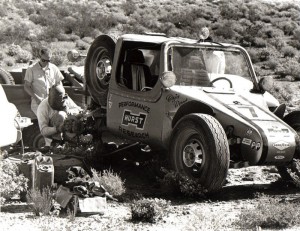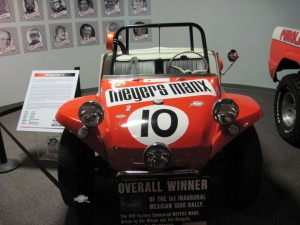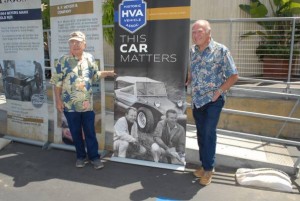The race we now know as the Baja 1000 originated back in 1967 but under a different name, the Mexican 1000. The race was a 950 mile course over brutal off-road terrain from Tijuana to La Paz, Mexico that was put together Ed Pearlman and Don Francisco. Pearlman was also known for putting together the National Off-Road Racing Association (NORRA) has been considered to be the Grandfather of Off-Road Racing.

Ed Pearlman and Don Francisco
PHOTO: Norra
Pearlman served as a Marine in World War One and as a way to keep up morale he organized jeep races in Guam where he was stationed. When he returned from service he purchased an Army surplus jeep and proceeded to go exploring the Baja Peninsula looking for good fishing spots along the way. In 1966 he met up with a pilot by the name of Don Francisco, who also had a huge interest in off-road exploration, and they teamed up to create the National Off-Road Racing Association. Francisco modified his personal airplane so that he could fly it at low altitudes and on regular pump gasoline so that he could fly up and down the Baja peninsula charting a course that could used for a giant Off-Race including service stops.
Using this crucial information that Francisco was able to get they were able to plot a course that started in Tijuana and ended 950 miles later in La Paz, Mexico. Pearlman played a crucial part in creating the rules and classes for the race. The rules were quite simple, each driver would set off on the 950 mile journey every 3 minutes and the only guidelines were they had to hit a total of 5 checkpoints along the way. In between those checkpoints there was no specific route planed so it was very important to have a good co-driver to help navigate through the desert. Pearlman decided that the name Mexican 950 didn’t have the right ring to it so they decided up on the name Mexican 1000, and a legend was born.

Hurst Performance “Baja Boot” Team 1967
PHOTO: Norra
On race day all kinds of trucks, buggies and motorcycles set off on the journey not knowing what lay ahead because nobody had done the course before. Bill Stroppe and Ray Harvick set the pace in a four-wheel drive Bronco and held the lead going into the first checkpoint but as the terrain changed to the rough stuff and the really soft sand they motorcycles started to shine. One of the most controversial things to happen during the race was at the final checkpoint, Villa Constitution. John Barnes was in the overall lead on his triumph as he entered the small village looking for the Checkpoint crew but was unable to find a single person. He searched the entire village for any “gringo” that could verify that he had been there so he could continue on the with the race. Soon Barnes heard another bike coming, it was J.N. Roberts who Barnes had just passed for the lead on the previous section of the course. Roberts joins in for the search for the missing crew to the point where 15 minutes had gone by since Barnes first pulled into the village. Soon after that there was another vehicle approaching but immediately they could tell this wasn’t a motorcycle, it had too many cylinders, it was Vic Wilson in his Myers Manx buggy pulling into town.

PHOTO: Pinterest
Turns out the missing crew was in a local Cantina having lunch, not expecting the racers for another hour or more. See in those days they didn’t have GPS tracking devices so it was a guessing game on how long each stage would take, unfortunately for Barnes and Roberts those early calculations were way off. Due to that mix up after leaving that checkpoint Barnes left in 3rd place, even though he had gotten there in first place with almost a 15 minute lead. Over the last section of the race the Myers Manx snatched up the overall lead and held onto it all the way to the very end finishing the 950 mile race in 27 hours and 38 minutes.

The 1967 overall winning Myers Manx
PHOTO: The Samba

Vic Wilson
PHOTO: SandSports
Now this is incredibly impressive when you put into consideration that this was back in 1967 when they didn’t have even a fraction of the suspension technology that is available on today’s desert racing vehicles. To think how brutal racing over 950 miles, 27 hrs straight in a car that barely has the suspension that some standard pickup trucks nowadays will have. They must have been beaten half to death by the time they got finished. But even though that was the case and will all the other mistakes that were made, a legend was born in the Mexican 1000.
